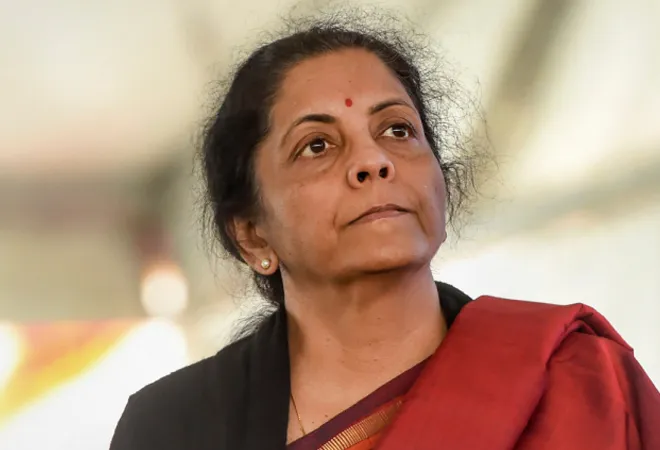-
CENTRES
Progammes & Centres
Location

In the month of November last year, National Statistical Office (NSO) of Ministry of Statistics and Programme Implementation released the estimates of GDP for the second quarter (July-September) Q2 of 2019-20. GDP at constant (2011-12) prices in Q2 has been estimated at Rs. 35.99 lakh crore, as against Rs.34.43 lakh crore in Q2 of 2018-19.
The growth rate reported was 4.5% – the weakest growth in more than six years of time. This is consecutive six-quarter decline in GDP growth, and will be the longest in the past 23 years if next quarter’s GDP growth rate falls below current 4.5% growth.
This is the most clear and hard macroeconomic fact that the economy is currently facing. However, the effective denial of this reality and a resultant policy paralysis continue unabated. Budget 2020 unfortunately underlined this economic ostrich–like behaviour once more. The sheer lack of urgency in dealing with this crisis also seems to be the longest in recent history.
Annual growth rates in gross and net national income provided in this year’s Economic Survey (Table 1) corroborates this statistical trend further.
| TABLE 1: Annual Growth Rates of Gross National Income and Net National Income | ||||||
| Gross National Income | Net National Income | Per Capita Net National Income | ||||
| Current Prices | Constant Prices | Current Prices | Constant Prices | Current Prices | Constant Prices | |
| 2012-13 | 13.5 | 5.1 | 13.2 | 4.5 | 11.9 | 3.3 |
| 2013-14 | 12.9 | 6.3 | 12.9 | 6.0 | 11.5 | 4.6 |
| 2014-15 | 11.1 | 7.5 | 10.9 | 7.5 | 9.5 | 6.2 |
| 2015-16 | 10.5 | 8.0 | 10.8 | 8.0 | 9.4 | 6.7 |
| 2016-17 (2nd RE) | 11.6 | 8.2 | 11.8 | 8.1 | 10.4 | 6.8 |
| 2017-18 (1st RE) | 11.4 | 7.2 | 11.3 | 7.0 | 9.8 | 5.7 |
| 2018-19 (PE) | 11.3 | 6.9 | 11.3 | 6.9 | 10.0 | 5.6 |
| 2019-20 (1st AE) | 7.6 | 5.0 | 7.6 | 5.0 | 6.8 | 4.3 |
|
* PE = Provisional Estimates; RE = Revised Estimates; AE = Advanced Estimates * Growth rates are based on 2011-12 series Data Source: Economic Survey, 2019-20 |
Since 2016-17 the growth rates in gross and net national income have kept on falling till date. The fall in the growth rate of per capita net national income (NNI) has been the starkest of them all. Growth in per capita NNI has fallen below the level at 2013-14 – when this government took over. This fall in per capita net national income signifies the dwindling income and purchasing power of the average Indian consumer at present. In the recent past, Indian economy for the first time is witnessing a slowdown due to a distinct lack of consumer demand.
In the light of that, there have been expectations from industry from this year’s Budget. However, such hopes have been belied, and apart from the mention of Rs. 100 lakh crores on infrastructure over next five years nothing much has been directed towards industry which can immediately boost the economy. Moreover, the irony is that this Rs. 100 lakh crore infrastructure proposal is being flaunted since last year, but details of actual deployment of such investment are yet to arrive in the public domain.
The Budget Speech reiterates the government’s so-called commitment of “doubling farmers’ incomes by 2022”. To do so, apart from flagship programmes like PM-KISAN it charts out a vision consisting of energy sovereignty through solar power, competitive farming, removing distortions in farm and livestock produce markets, necessary investments, and bringing in more technology.
| TABLE 2: Budget Allocations, Net of Recoveries, in Agriculture (in Rs. Crore) | |||||||||
| Budget 2019-2020 | Revised 2019-2020 | Budget 2020-2021 | |||||||
| Revenue | Capital | Total | Revenue | Capital | Total | Revenue | Capital | Total | |
| Dept. of Agri, Cooperation & Farmers' Welfare | 130450.50 | 34.70 | 130485.20 | 101870.20 | 33.85 | 101904.00 | 134349.50 | 50.32 | 134399.80 |
| Dept. of Agri. Research & Education | 8078.76 | ... | 8078.76 | 7846.17 | ... | 7846.17 | 8362.58 | ... | 8362.58 |
| Source: Union Budget Documents, 2020-21 |
But, if we look at the budget allocations, net of recovery, for both Department of Agriculture, Cooperation & Farmers’ Welfare and Department of Agricultural Research & Education (Table 2) then total budgeted allocation compared to last year’s total allocation have increased only 3.0% and 3.5% respectively. Lower absolute amount of allocation in Department of Agricultural Research & Education belies the promise to bring in more technology in the sector. Moreover, the capital expenditure budgeted in agriculture shows paltry amounts allocated as earlier.
So, the vision about agriculture may be grand in the speech but budget allocations do not support that vision in any way.
While no new measures to boost services can be found in the Budget, another way to boost demand immediately could have been drastic increase in allocations in social sectors.
In health, the Budget Speech says that around Rs. 69,000 crores – including Rs. 6,400 crores for Prime Minister Jan Arogya Yojana (PMJAY) – has been allocated. Department of Health & Family Welfare allocation has been increased by 3.8%. Though Department of Health Research allocation has increased 10.5% the absolute amount of allocation is Rs. 2,100 crores, Rs. 150 crores more than the revised estimate of health allocation in 2019-20 (Table 3).
| TABLE 3: Budget Allocations, Net of Recoveries, in Health (in Rs. Crore) | |||||||||
| Budget 2019-2020 | Revised 2019-2020 | Budget 2020-2021 | |||||||
| Revenue | Capital | Total | Revenue | Capital | Total | Revenue | Capital | Total | |
| Dept. of Health & Family Welfare | 60908.22 | 1750.90 | 62659.12 | 60810.86 | 1848.26 | 62659.12 | 63946.10 | 1065.70 | 65011.80 |
| Dept. of Health Research | 1900.00 | ... | 1900.00 | 1950.00 | ... | 1950.00 | 2100.00 | ... | 2100.00 |
| Source: Union Budget Documents, 2020-21 |
Under Ayushman Bharat floated in 2018, the government proposed to create 150,000 Health and Wellness Centres (HWCs) by transforming existing sub-centres and primary health centres and also increase the coverage of PMJAY. However, the Speech mentioned that now there are around 20,000 empanelled hospitals. So, there are gaps in implementation of existing schemes, but the allocation does not look to be capable of filling these gaps.
In the first term of the present government, a lot has been discussed about education and skilling exercises. India’s demographic dividend – an increasing proportion of young population – had been touted again and again as an economic advantage. Flagship programmes like Skill India were launched with much fanfare. However, the allocations and implementation have always been proved to be inadequate. This year’s budget is also no exception from that trend.
| TABLE 4: Budget Allocations, Net of Recoveries, in Education (in Rs. Crore) | |||||||||
| Budget 2019-2020 | Revised 2019-2020 | Budget 2020-2021 | |||||||
| Revenue | Capital | Total | Revenue | Capital | Total | Revenue | Capital | Total | |
| Dept. of School Education & Literacy | 56536.63 | ... | 56536.63 | 56536.63 | ... | 56536.63 | 59845.00 | ... | 59845.00 |
| Dept. of Higher Education | 36197.01 | 2120.00 | 38317.01 | 36197.01 | 2120.00 | 38317.01 | 37239.52 | 2227.00 | 39466.52 |
| Source: Union Budget Documents, 2020-21 |
Budget allocations in Department of School Education and Higher Education have increased by 5.9% and 3.0% respectively (Table 4). Moreover, no change in budget estimates and revised estimates in 2019-20 indicates a probable lack of update on the spending last year.
Amidst reports of drastic fall in rural demand of cheap and easily available consumer goods like biscuits, strengthening Mahatma Gandhi National Rural Employment Guarantee Act (MGNREGA) could have been one of the options to stimulate the rural demand. The allocation for MGNREGA, on the contrary, has been cut by Rs. 10,000 crores – compared to the revised estimate for 2019-20 at Rs. 71,000 crores. When the unemployment level in rural India is going through a sharper rise, this reduction in allocation is inexplicable.
Food subsidy is another important element in maintaining rural demand. Last year’s budget allocated Rs. 1.8 lakh crores for food subsidy – a much closer amount required to meet the costs of grains distributed through public distribution system and other welfare schemes. This year the allocation has undergone a drastic cut to Rs. 1.11 lakh crores. Interestingly, revised estimates show that last year’s expenditure on food subsidy was Rs. 1.08 lakh crore.
Therefore, all possible avenues of spending – which could have stimulated the economy immediately by providing purchasing power in the hands of common people – have been squarely ignored. It seems that the government hopes that structural reforms of the recent past (some of which are greatly botched up) would start pay dividends immediately.
That is surely a baseless hope if recent hard statistics on macro-economy are seen in isolation. Unfortunately, this year’s Budget relies more on that divine hope than current economic facts and figures.
The views expressed above belong to the author(s). ORF research and analyses now available on Telegram! Click here to access our curated content — blogs, longforms and interviews.

Abhijit was Senior Fellow with ORFs Economy and Growth Programme. His main areas of research include macroeconomics and public policy with core research areas in ...
Read More +